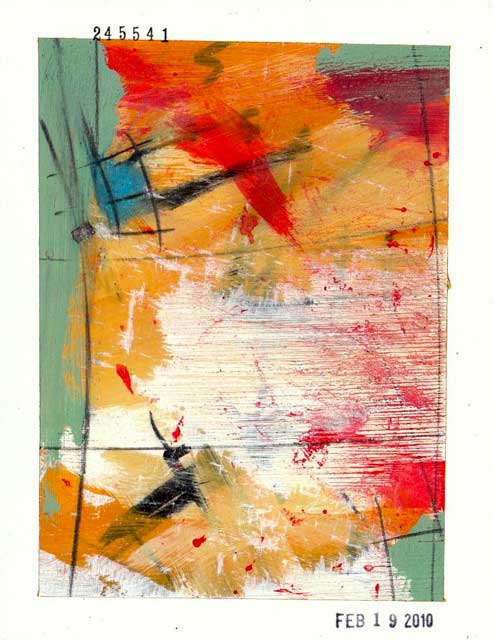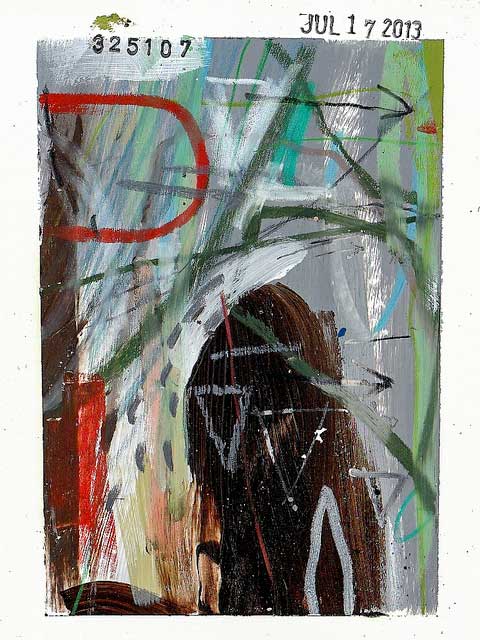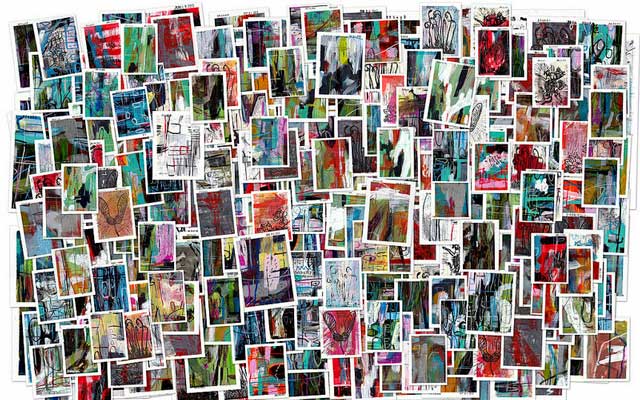The intent wasn’t always to create a million paintings. Speaking of his early art-making days with his brothers-in-arms back in high school, where the seeds of the idea were planted, artist Jason McHenry says, “We actually just used them like currency, kind of. We would make little mini paintings. That’s how it started… just amassing a bunch of these things, you know? We would all just push each other to make a new version of our own currency — like one dollar bills and five dollar bills.”
McHenry and his best friend Chris Dyer are the only two that stuck to it over the years. Now the project has a name, One Thousand Thousand, and a mission to produce one million paintings. Although the impetus was simply to make as much art as possible surrounded by his friends, it eventually took McHenry down an often solitary path. Today he is reaching out to other artists to participate in the project to assure the goal is reached in his lifetime.
“One Thousand Thousand is Christopher Dyer and Jason McHenry,” McHenry is quick to point out. “I honestly do more of the work, produce more pieces; he’s a senior executive at a company in Denver. We’re like partners in crime artistically. All the big projects that we’ve done, we’ve done together. So we push each other that way.”

McHenry, 43, and his wife, Cathy, live in the South Bay now. He was born and raised in St. Louis, MO. His formative years are as colorful as the art he began painting just a short time later. Describing his youth, McHenry says, “I was the worst. I was raised by bikers. My whole family was involved with porn and tattoos.”
Like many kids growing up around a family-owned business, McHenry was asked to pitch in and help out from time to time. He earned his allowance by way of a broom and a bucket of bleach. He swept the floors of the family’s adult business and soaked clean the quarters he picked up in his bucket over night. The next day he’d dry them off and head to the arcade to play Pacman.

McHenry went to four different high schools in the 9th grade. He kept getting kicked out of them. They finally decided to have him tested and realized there wasn’t anything wrong with him; the tests revealed that he was both highly intelligent and exceptionally creative. As a result, he was sent to Central Visual and Performing Arts High, a magnet school in the St. Louis Public School district, which describes itself as being “focused on synergistically developing both the artistic and academic student.”
McHenry describes it as being focused and condensed periods for academics with larger blocks of time for creative expression. “It’s a lot like FAME,” he says.
“In high school and when the project first started the whole point of it was that we would just be pushing each other to make new art. So Chris wouldn’t wanna not make anything during the week, because then when it came time for us to show each other what we had done, he’d get savaged. Like ‘What? You didn’t make anthing? Get at it!’ You had to produce, because everybody else was. That was the point of it in a lot of ways.”
“We’d also sit around and do them together as a group. There’d be 5 or 6 or 10 people and we’d all make them on the spot. Sort of like artist trading cards before there were artist trading cards — limited, one-offs.”
Were you guys thinking of it like a factory?
“In a way, yeah. Those are all big influences. Warhol and stuff like that. That’s when Mark Kostabi really got famous and he was known for not even picking up a brush. He would basically just sign stuff. It was like that kind of dialog. At the same time, the work was the work, but it was really an excuse that we could all just sit and talk about these conversations. Because we’re high school students, but we’re skippin’ school to go up to Chicago to see some opening at the art museum up there.“
What about the Reverend Howard Finster? The way you number your works reminds me a bit of him. Are you aware of Finster yet?
“Yes, in high school around that time. He was a huge influence. That’s where the idea had to have come from at some point. Part of it. Part of it was Jean-Michel Basquiat doing little anti-product postcards. I think I found Finster by way of Talking Heads and Little Creatures, and R.E.M. ‘cause there was an R.E.M. cover in Rolling Stone around early to mid-eighties with an article inside on Howard Finster.”

So you keep doing this all through high school. Then what?
“Some of us went to the same college afterwards, so we kept doing it. I had saved them all from that time. I had 100. Then I had 500. Then I had 1000.”
“I had awesome scholarship offers based on my portfolio, but I had a crap G.P.A. So I went to a community college at first to get a demonstrable grade point average. And then I got a scholarship to Saint Louis University and eventually I finished my degree at University of Nothern Colorado.”
You shared with me that you had learned of the outsider artist, Henry Darger, around your second year in college. How did seeing his work for the first time affect you?
“Oh profoundly. Darger was part of the discipline,” explains McHenry. “There was a Darger exhibit at Chicago Museum, I believe, and one of the pieces was this cross-section of a board that every day, or every other day, or seven times a day, he would do a coat of paint. Just a layer of paint. So what you were looking at was like tree rings basically. The board was a two-by-four, but the thing was like (in my memory at least) a foot and half or so thick. Just a lot. Whoa, that’s like hundreds and hundreds and hundreds of layers of paint. That was remarkable to me.”
Like Darger, McHenry and associates have been religiously laying down the layers of paint and mixed media day after day for over twenty years now. He’s created and painstakingly documented more than 330,000 works in the One Thousand Thousand edition to date. To put that into perspective, imagine laying the 7.125 x 5.25 inch pieces end to end length-wise, that’s over 37 miles of art!
While One Thousand Thousand has never been about making money, you can find available works online reasonably priced around $5. I’ve also seen them at festivals and events completely framed for just $10.
I’m including a Call to Artists from McHenry’s Anti-Product website here. “In the hindsight that is afforded to us after 20 years of going at this project, we have come to realize that it would be a whole lot easier for us to reach our goal of a million paintings in some timely fashion should we get a little help.
“If you are interested in participating in this project in some way you are seriously encouraged to contact us and let us know.”
Find out more about the One Thousand Thousand project at anti-product.com.